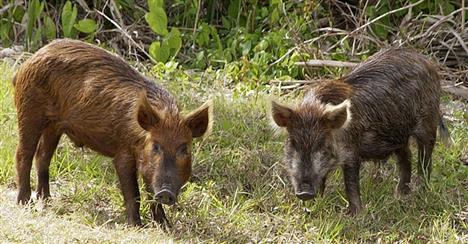Hundreds of feral hogs killed in Northeast and Southeast Arkansas during USDA partnered hunt
by March 15, 2018 9:58 pm 3,646 views

Feral hog populations have exploded in recent years in Arkansas and across the country, and officials are employing multiple means to deal with the problem. In late February and early March, the United States Department of Agriculture”s Animal and Plant Health Inspection Service Wildlife Services, partnered with the Arkansas Game and Fish Commission and other agencies to conduct a feral hog hunt in Northeast Arkansas and Southeast Arkansas.
At least 615 feral hogs were killed during hunt, according to USDA. Hunters shot the rogue animals from helicopters in the air. The hunt was held on private and public lands. In the Cut Off Creek Wildlife Management Area (WMA) near Monticello, at least 226 feral hogs were eradicated. In the Choctaw Island WMA near the Mississippi River in southeast Arkansas, at least 87 were killed.
Hunters killed 78 feral hogs in the Big Lake WMA near Blytheville, and another 37 were killed in the Trusten Holder WMA in Arkansas County. At least 187 feral hogs were shot and killed on private lands. Some of the WMAs had to be temporarily closed to accommodate the hunt, according to the USDA.
Arkansas Agriculture Secretary Wes Ward previously told Talk Business & Politics the state doesn’t know how many feral hogs are roaming the woods and crop lands across the state, but it’s growing and it’s becoming a serious problem. The Arkansas Feral Hog Eradication Task Force will consider several options this year to combat the problem, Ward said. The state could have its own feral hog hunt, it could try to trap some of the animals, or it could use poisons to kill them.
“We know this is causing a lot of row crop damage,” Ward said.
This spring, the task force hopes to complete a study to determine how many feral hogs are in Arkansas. These creatures have an estimated total national population between four and five million across 39 states. It is estimated feral hogs cause $1.5 billion annually in agricultural and ecological damage, USDA reported.
Feral hogs are not native to the United States. They are an invasive species, a public nuisance and a threat to Arkansas, according to the Arkansas Game and Fish Commission. They compete for food resources, destroy habitat by rooting and wallowing and will eat ground-nesting birds, eggs, fawns and young domestic livestock. They also carry up to 45 bacteria, diseases and parasites, including Trichinellosis, Brucellosis and swine herpes virus.
Hunting and shooting feral hogs has been implemented for the last few decades. It can chase feral hogs away from crops or food plots temporarily, but they return or become a problem for a neighboring landowner. Studies show at least 66% of a hog population must be removed each year just to prevent it from growing. Hunting has shown to reduce hog populations by up to 50%.
The bait formulation in this product is warfarin-based and has demonstrated efficacy against feral hogs at a formulation strength one-fifth the concentration of warfarin that has been registered for controlling rodents in the U.S. for more than 60 years. The Environmental Protection Agency (EPA) registered Scimetrics’ Kaput Feral Hog Bait on January 3, 2017. Kaput Feral Hog Bait is the only toxicant approved by the EPA for the control of feral hogs. This product is not registered for use in any other state.
